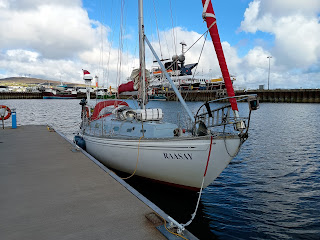So. I don't know whether trying to plan a summer cruise is really a separate entertainment from actually going sailing - there seems to be so little relationship between the two ...
I had been watching the 'Windy' long-range forecasts for a while, and trying to decide whether I should go down the canal and up through the islands, or go north and then up the canal. The first is usually the best plan, but a few days before I left it looked like the forecast was pointing to northerly airstreams as I came out of the canal.
So at the last possible minute, I decided to go North, sort of.
My first thought was to go straight to Wick from Lossiemouth - or perhaps to Sinclairs Bay, which is a good anchorage in westerly or south-westerly weather. I thought Wick, because the wind was light south easterlies on Friday when I planned to leave. Then I saw that the wind was shifting to the west on Sunday, and that I could take the opportunity to spend a day in Portmahomack and visit my sister in Tain.
I finally headed (properly) north on Sunday morning, but there was too much residual easterly swell for Sinclairs Bay to be a good idea, so I did go to Wick. I spent two nights there, mainly because I had some online meetings on Monday afternoon and Tuesday morning. I'd thought of heading round to Sinclairs bay and anchoring on Monday morning, but I decided that paying for another night was less risky.
The westerlies had arrived by Monday afternoon, though, so I was able to make a good passage from Wick to Deer Sound in Orkney. The wind was light, and I ended up doing a good deal of motoring.
A bit south of Copinsay, the weather closed in - mist, rain, cold.
I went (I now realise) too far up Deer Sound, anchoring of Suckquoy. It's a bit stony there. I'd have been better off in the main sound where there is more sand, I think.
Strong westerlies were forecast - 20 knots - and I contemplated waiting them out. This was a good idea until the anchor dragged at 3am. At first, I stopped it by letting out more chain - in fact, the whole 40 metres (in a maximum depth of 6). I also have octoplait spliced onto the chain, but I didn't let that out.
Everything was fine then for 12 hours. But as high tide approached and the wind increased (25-30 knots), the anchor dragged again, and it didn't stop this time.
It took me an hour and a half to get it up, watching an approaching lee shore with trepidation. I did a lot of engine-powered anchor dragging to keep off and give me time to lift it. When I finally got it up, it was enmeshed in a huge ball of weed, so it's not surprising it had stopped holding.
I decided not to reset it, but to head round to Kirkwall. I had friends to visit there, and some shopping to do.
I was a bit surprised to find that there was a £5 charge per night for using electricity in the marina. When I came in, the person on watch just said 'Oh, you can plug in there.' without warning me about the cost. I think the most I've ever been charged before was about £2.50 (and may marinas just include in the overnight fee).
I stayed in Kirkwall visiting and touring for most of yesterday (Thursday). My friends took me to the Broch of Gurness. The bay there 'Sands of Evie' looked like perfect shelter, so that's where I spent last night.
I had a strange engine issue coming out of Kirkwall. When I tied up there on Wednesday night, there was a strange 'clunk' when I put it astern to dock. When I started the engine again on Thursday it was hard to start and ran rough for a minute. Then there was a lot of smoke in the cabin - as though I had a cracked exhaust.
I shut everything down and ventilated the smoke. Then I opened up the engine compartment and looked for damage. I couldn't find any, so tried starting the engine again. This time it behaved perfectly, and no smoke.
Then, leaving Kirkwall, there was a clunking from the prop or prop shaft for about a minute or two. That also stopped, and hasn't reappeared.
I spent some time at anchor this morning doing further explorations, and I haven't been able to figure out what happened. Everything is behaving properly.
I took the opportunity to grease the gearshift controls and check the gearbox oil. The controls now work more smoothly, but the gearbox oil level is far too high. This should cause problems with the cone clutch, but unless that was the 'clunk' in Kirkwall, I haven't been aware of anything. It must have been like that for a few years ...
I can't lower it just now because there isn't a drain plug that I can find and I don't have an extractor pump on board.
The only other thing I wonder is whether the engine was in gear when I tried to start it the first time in Kirkwall. This would have made it unhappy, and might have popped the jprop into a strange configuration (causing the noise on the way out). It doesn't explain the smoke, though.
I need to decide whether to explore the north and then sail back round the north coast, or head down to the canal. I don't think I fancy doing the canal with an uncertain engine/gearbox. I have a few days to think (and experiment) before I decide.















